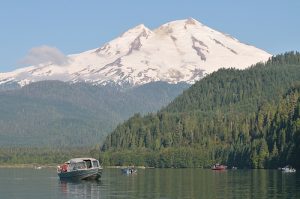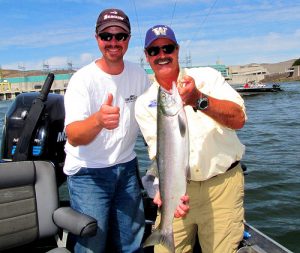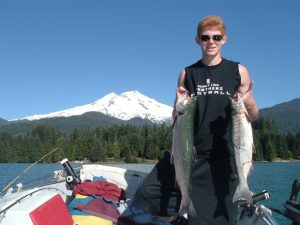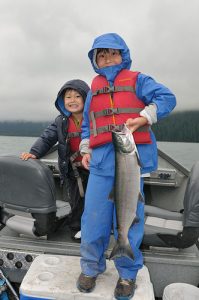Sockeye countdown begins in many areas with Skagit River fishery opening soon 2
The salmon watch has commenced for sockeye – one of the first summer migrating salmon species – making the long journey back from the ocean to natal streams and lakes.
This has many anglers organizing their gear to fish the Skagit River and Baker Lake where 47,000 sockeye are forecast to return somewhat down from 55,054 last year.
“The sockeye return forecast is pretty similar to two years ago, and that was a good year for fishing,” said Brett Barkdull, a state Fish and Wildlife biologist.
The three-year-old sockeye returnees are coming off a juvenile outmigration of 939,879, but more importantly a two-year-old outmigration of 787,650 that makes up the majority of adult sockeye returning this summer.
“If we used the median age specific from smolt to adult survival rate historically the ocean age two fish is 5.1 percent, and the age three fish is 1.2 percent,” Barkdull said. “The survival rates for sockeye are all over the map. It is like throwing a dart into the middle of dart board and hoping it is good year.”
In the last few years, ocean age two-year-old sockeye had a survival return rate between 12 percent and 1 percent, which indicates it was all over the dart board.

Mount Baker looms in the background of Baker Lake where sockeye fishing is expected to be good later this summer. Photo courtesy of David Kim.
“If you look at run timing there already should be fish in the river when it opens,” Barkdull said. “It does change from year-to-year, but the best two weeks of fishing should be last week of June and first week of July when a lot of fish are passing through. That is based on a normal run curve.”
The first sockeye opportunities will begin on the Skagit River from Memorial Highway Bridge to Gilligan Creek, which opens June 11 through July 15 (closed June 28-29, July 6-7 and July 11 to avoid gear conflict with the tribal fishery).
With all the snow in the hillsides above the river, anglers can expect plenty of glacial runoff, and high water and flows now through early summer.
“Based on one data point when we had really high water the river fishery seems to be better wit those types of conditions, and terrible when we don’t have much runoff and low water levels,” Barkdull said.
That river fishery will be followed by Baker Lake opening July 8 through Sept. 7 with the typical peak being in late-July and early-August.
Last year’s lake fishery experienced one of those strange seasons when there wasn’t any time you could take day-to-day success to the bank.
“There was a lot of inconsistency at Baker Lake last summer, and the fish didn’t seem to be holding in upper locations of the lake like they usually are,” Barkdull said. “The fish were scattered around in different areas. It appeared the majority of sockeye had vacated a particular area, and moved back down toward the dam. It was really a matter of fishing in the right place at the right time last year.”
Like any fishery moving around will be a key to success so if you don’t mark much on the fish-finder head to another location.
“In the past it wasn’t like that and people didn’t have to do much searching, but last year the fish used the whole reservoir,” Barkdull said. “It kept people guessing a little bit more than in the past. Surprisingly during our creel surveys last year, I would say on average the fishing was just as good last year as it was in previous years.”
The key to tracking when the best fishing occurs in the lake is to follow the fish trucking on WDFW website at http://wdfw.wa.gov/fishing/salmon/sockeye/baker_river.html.
Baker sockeye were first introduced from an artificial enhancement that started in 1896 when the state built a hatchery on Baker Lake. The natural run at that time was estimated to be approximately 20,000 fish, which was way before the dams were built.
Success of sockeye returns is based on improved juvenile fish production. Puget Sound Energy work crews have a huge fish barge collector anchored above Lower Baker Dam on Lake Shannon. This draws migrating juvenile salmon unto a funnel where they’re held until being transferred below the two dams and released to begin their outmigration.
Since the 1920s, annual adult sockeye returns averaged 3,500, and then by the early 1980s it dropped off the charts and hit an all-time low of 99 fish in 1985.
Also, anglers looking forward to the chinook salmon fishery – opening this Thursday (June 1) through July 15 in the Skagit River from the Highway 530 Bridge at Rockport to Cascade River Road Bridge and the Cascade River from mouth to Rockport-Cascade Road Bridge.
“There’s chinook already in the river, no question, and we have fish in the hatchery,’ Barkdull said.
Sockeye outlook elsewhere

Dave Graybill holds a sockeye he caught from Wanapum area of the Columbia River. Photo courtesy of Dave Graybill.
All eyes will also be glued to the Columbia River sockeye returns, and to a lesser degree on the Lake Washington returns situated in the backyard of the Emerald City.
The Columbia River return this summer is 191,200 – 137,000 to Okanogan River and 54,200 to Wenatchee River.
“The Columbia return is a strong run-size on paper and not a record return, but sockeye are definitely a challenge to forecast,” said Joe Hymer, a state Fish and Wildlife biologist. “Last year we had a forecast of 100,000 and ended up with 350,000 so we can only hope that something similar materializes this summer.”
Hymer says on a positive note high water like we’re currently seeing this spring will help boost the sockeye fishery as they tend to migrate closer to shore allowing bank anglers along the lower river below Bonneville Dam better chances to target them.
“We could see decent catches this year, and that is good news for anglers from the lower areas (below Bonneville Dam) clear upstream to Okanogan area,” Hymer said.
The Lake Wenatchee fishery will open around the third week of July, and is based on sockeye passage at Tumwater Dam and mainstem Columbia River Dams. The spawning goal is 23,000 fish so any above that will be free game for sport anglers.
The Lake Washington forecast is 77,292, which falls well short of the 350,000 escapement goal before any fishing can be discussed. It will make for great viewing at the Ballard Locks fish ladder viewing window beginning as soon as early June, but highly unlikely a fishery will occur.
But, with that said due to unpredictability of sockeye returns don’t count out a Lake Washington fishery until an in-season peak run-time happens in early- to mid-July.
State Fish and Wildlife is still developing the fishing regulation pamphlet for 2017-18, and should be available soon online at http://wdfw.wa.gov/fishing/regulations/ or at local tackle shops.
Mark Yuasa
Outdoor Line Blogger
710 ESPN Seattle




Thank you Mark Y at least you still get to do what you Report fishing and hunting NEWS to us.
Mark, Congratulations on your new position here! We all look forward to reading your informative columns at Kiro/ESPN. Best of luck in this new chapter in your life and will be seeing you out on the water this summer! JayT